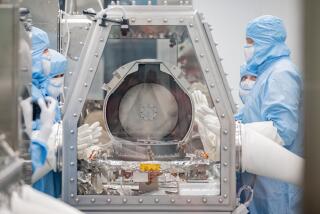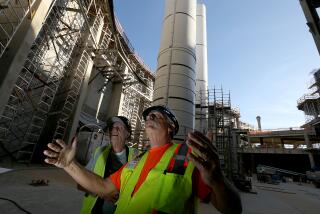Astronauts Pop the Hood on Malfunctioning Hubble
- Share via
HOUSTON — Working more than 370 miles above Earth with ratchet tools, two spacewalking astronauts Wednesday fitted the Hubble Space Telescope with new instruments needed to restore its unparalleled view of the cosmos.
It was the first of three spacewalks to be conducted over three days on the $3-billion observatory and, by far, the most important. The Hubble has been out of service since mid-November.
Keenly aware of the magnitude of the job, Steven Smith and John Grunsfeld floated out of space shuttle Discovery’s hatch almost an hour early and quickly began organizing their tools in the cargo bay, where the Hubble was latched down.
Four hours later, the men had replaced all six of the Hubble’s gyroscopes. The work was made more difficult by stubborn bolts and storage-bin lids that wouldn’t close.
A quick electronic check of the new gyroscopes showed that they all work. Additional testing is needed, though, before NASA can declare success. In any event, it will be several weeks before the Hubble resumes making observations.
The spacewalkers moved on to other work but soon fell behind.
It took them extra time and effort to open coolant-line valves on a disabled infrared camera, then they had trouble latching the doors to the bay containing the equipment.
By evening, the astronauts were so far behind that Mission Control at Johnson Space Center told them to skip some of their planned battery repairs. The spacewalk was expected to last seven hours.
The Hubble, which was plucked from space with Discovery’s robot arm Tuesday, has been useless to astronomers since a fourth gyroscope failed Nov. 13. A minimum of three are needed to keep the 43-foot, 25,000-pound telescope steady as it aims at stars, galaxies and other celestial targets.
NASA believes the failures were the result of corroded wires. To avoid a repeat of the problem, engineers used pressurized nitrogen rather than air to force fluid into the new gyroscopes. The oxygen in the air was thought to have caused the corrosion.
The gyroscopes, which come in 24-pound packs of two, cost $8 million in all.
More to Read
Sign up for Essential California
The most important California stories and recommendations in your inbox every morning.
You may occasionally receive promotional content from the Los Angeles Times.













